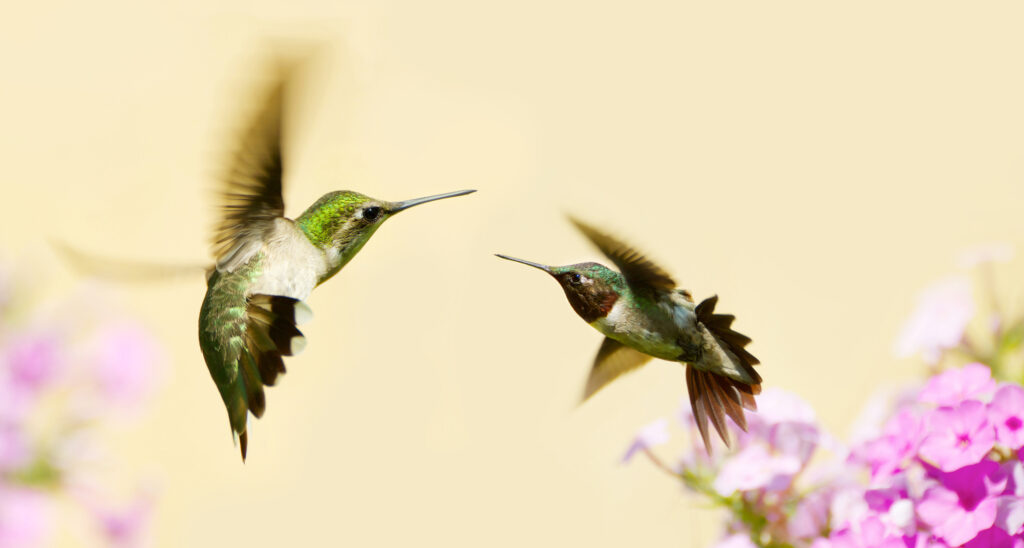Everyone loves hummingbirds! When you see that familiar flash of color in your garden or at a window, it always seems to be just as thrilling as your first time spotting one, doesn’t it?
If you’re looking to amp up those ornithology skills, it’s helpful to know the differences between male and female birds. After all, there are so many different species of hummingbirds in North America!
Even better: You’ll have a new fun fact to share with your friends the next time you’re enjoying the patio of your favorite restaurant and notice a beautiful hummingbird hovering over the drink nectar nearby!
Do Male and Female Hummingbirds Look Different from Each Other?
The first step in identifying a hummingbird’s sex is by understanding the difference in appearance between males and females.
Similar to other birds, hummingbirds are sexually dimorphic. That means that, unlike cats, dogs, and other sexually monomorphic animals, the physical appearance of hummingbirds (like their bright feathers) is directly linked to their sex.
A great example of this is the Ruby-throated hummingbird with its bright coloring. Males, with ruby-red throats (hence their distinctive name), can also appear black in some lighting. Female birds, on the other hand, have white throats—sometimes appearing as light gray.
Take a glance at the tail feathers for another easy clue. In adulthood, males have forked tail feathers and black, pointed feathers on the outside. A female’s tail is more rounded and blunt. Their flashy feathers are black but also tipped in white.
Furthermore, most males are smaller than females.
What About Juveniles?
Keep in mind that juveniles of all sexes are more likely to resemble females.
Each of the common hummingbird species in North America has slight differences in appearance between males and females. When in doubt, it is usually safe to assume that hummingbirds with vibrant, brightly-colored feathers are males, and duller specimens are females or juveniles.
Do Male and Female Hummingbirds Exhibit Different Behaviors?

No matter what species of hummingbirds you identify in North America, a little bit of behavioral knowledge will help you identify a male or female bird.
Males and females exhibit different behaviors. Although both will likely visit a lush garden or hummingbird feeder, their other behaviors will be based on their sex.
Male Behaviors
Male hummingbirds are more aggressive than their female counterparts, especially when visiting feeders. They are competing for resources, and they act like it!
In fact, many birders have realized that they need to hang each of their feeders out of sight from the others if they want to avoid fights breaking out among birds.
Another male trait is showing off to attract female mates. They may dance, zig-zag back and forth, and fly in acrobatic loops to draw attention to themselves. They will also dive-bomb toward the ground and catch themselves at the last moment to impress their potential mates—these behaviors are all considered courtship displays.
Female Behaviors
Females can actually be quite aggressive, too! This is primarily seen in the protection of their nests, as opposed to showing off or competing for resources.
Because females are the ones who build a nest, lay and hatch eggs, and raise hatchlings into juveniles, they will also be the ones protecting their nests from males.
Do Males and Females Migrate at the Same Time?
A fascinating aspect of hummingbird migration is that they don’t all leave together for their journeys north or south.
Males typically leave a few weeks earlier than females.
That means the first hummingbirds you see in the northern migration zones are typically males. Females arrive two or so weeks later.
Of course, there are no juveniles at this point as all arriving hummingbirds are adults.
Male and female hummingbirds divide their migration journeys because it allows the birds to avoid competition for essential resources along the way. Some hummingbirds travel thousands of miles during their journey, and they need to eat as much as possible.
Hummingbirds eat bugs, larvae, and nectar from flowers, so it is much better to spread out their travel. Males will also leave for their southern journey home before females, just like they did coming north.
The Benefits of Differentiating Between Male and Female Hummingbirds
Sure, it’s fun to show off your new facts! But there are other important reasons to know the differences between males and females.
If you are observing aggressive behavior from your hummingbirds, it can be incredibly helpful to know that this is likely due to competitive males. You can separate your hummingbird feeders or try other strategies for reducing male aggression.
Knowing that hummingbirds migrate over the course of several weeks can help you decide when to leave your feeder up and when it is time to take it down.
Whether you are a hummingbird expert or a novice birder, there are plenty of things to learn about these fascinating little creatures with colorful feathers!
Sources
Encyclopedia Brittanica. (2022). Sexual Dimorphism. Retrieved 2022
The Wood Thrush Shop. (2018). Differences In Ruby-Throated Hummingbirds. Retrieved 2022
C, J. (2020). Best Place to Hang Your Hummingbird Feeder. Retrieved 2022
Mayntz, M. (2022). Hummingbird Behavior and Aggression. Retrieved 2022
C, J. (2020). When Do I Take Down My Hummingbird Feeder for the Winter? Retrieved 2022

